Ad Disclosure
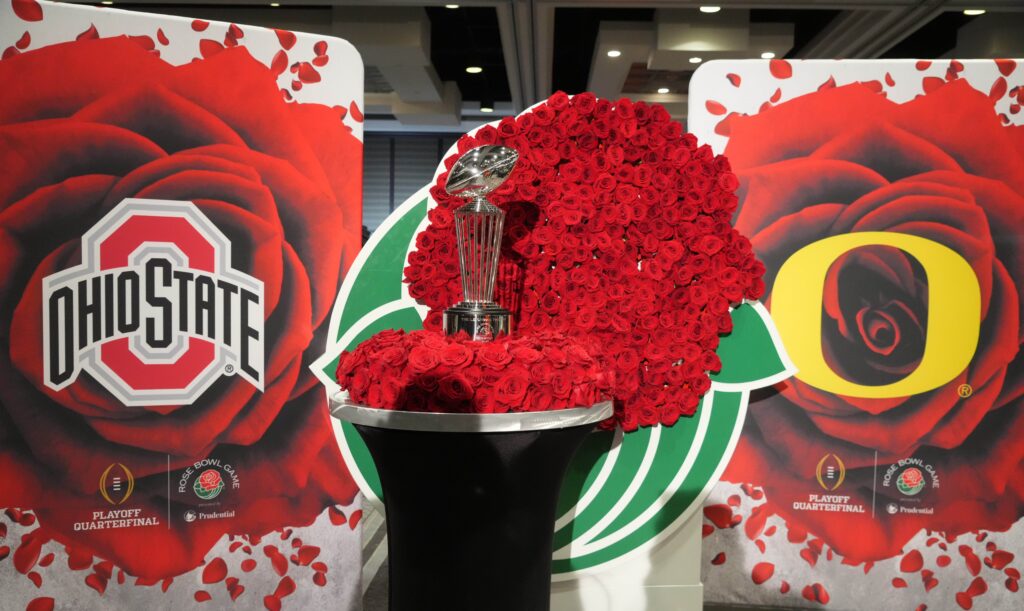
The Ultimate Playoff Quarterfinals Preview: Upsets, blowouts and madness beckon
By Matt Hinton
Published:
Everything — and we mean everything— you really need to know about the quarterfinal matchups in the inaugural 12-team College Football Playoff.
(Betting lines via FanDuel Sportsbook.)
Fiesta Bowl: Penn State (-11.5) vs. Boise State
It’s been awhile, but I can’t quite get my head around Boise State’s arrival on this stage without thinking about the great Chris Petersen-era Boise teams of the late aughts, outfits that regularly made a mockery of the postseason system at the time. From 2006-11, the Broncos pulled off 3 undefeated regular seasons and 5 top-10 finishes in the BCS standings without so much as sniffing a title shot, their second-class status sealed before they’d even played a down.
Those teams backed it up at every opportunity, too, boasting annual wins over power-conference competition. Much has been made of the 2011 Alabama-LSU rematch in the title game as the death knell for the BCS, but by that point, I always felt like it was half-dead already from embarrassment that the Boises of the world never stood a chance.
Well, now they do.
The ’24 Broncos haven’t built up quite as much national cred as the best of the Petersen-era teams, partly because they had little to begin with coming off a tumultuous, 8-6 finish in 2023, and partly because they didn’t notch a marquee win — if anything, they earned more respect from their marquee loss, a 37-34 decision at Oregon decided on a walk-off field goal back in Week 2. Combine that with the 12-game winning streak that followed, a conference championship, and the Heisman runner-up (Ashton Jeanty), and you have a team so comfortably in the field that it qualified for a first-round bye with room to spare.
Fifteen years late, sure. But better late than never.
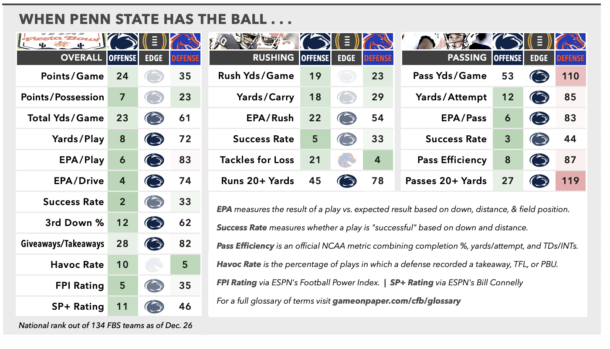
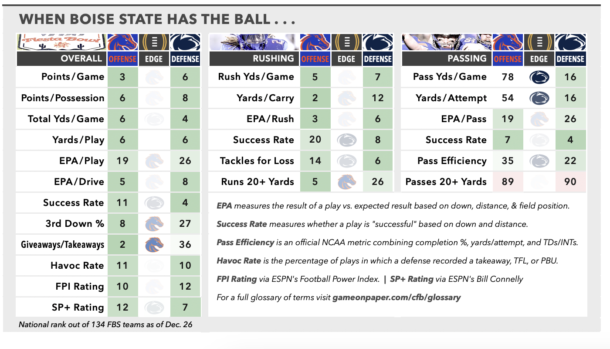
Ashton Jeanty is Him: Need I go on? Heisman runner-up, unanimous All-American, viral highlight machine, future first-rounder, all-purpose dynamo. Jeanty is not just the FBS rushing leader; he’s ahead of the next guy on the list by more than 800 yards. He’s within striking distance of Barry Sanders’ single-season rushing record, which speaks for itself even without all the caveats and asterisks that accompany that distinction.
Jeanty’s raw production is absurd in any era, but especially in one that seems to have collectively decided at some point that the concept of the workhorse running back was due for the scrapheap. He’s carried a full load from start to finish and put up numbers against everybody, including Oregon, where he accounted for 200 yards and 3 TDs in the Broncos’ last-second loss in Week 2. That was an average night for him.
On that note, if there’s any aspect of Jeanty’s game at this point that could possibly be called underrated, it’s just how much of his output he creates himself. Per PFF, he forced more missed tackles (135) and generated more yards after contact (1,889) this season than any other player in the PFF database, dating to 2014.
Like, a lot more, on both counts. No other college back in the past decade is even within sniffing distance of those numbers. Nearly 1,900 yards after contact! Just for some context, in his Heisman-winning season in 2015, Derrick Freakin’ Henry was credited with an amazing 1,339 yards after contact, easily the best in the country that year and among the best of the decade — and still more than 500 yards fewer than Jeanty has generated so far in 2024, on 30 more carries. I’ve used up my allotment of italics for this bullet point, let’s move on.
Alas, challenges await: Anyway, as you can see from the tale of the tape (and probably could have guessed without it), Penn State is the stiffest defense Jeanty has faced this year by some distance, both according to the conventional stats and advanced metrics like EPA and Success Rate. Not that the Nittany Lions are impervious to the run: Even including negative yardage on sacks, they’ve taken their lumps against USC (189 yards on 7.9 per carry), Ohio State (176 on 4.4 per carry), and Oregon (183 on 4.3 ypc in the Big Ten Championship Game). Not coincidentally, those games resulted in 2 losses and a razor-thin escape in overtime.
Still, despite the very real threat Jeanty poses at all times, Penn State’s across-the-board talent edge everywhere else should allow the Lions to sell out to stop the main character without worrying too much about the surrounding cast. Boise’s wideouts are unlikely to shake Penn State’s DBs downfield, and diminutive Boise QB Maddux Madsen should feel Abdul Carter‘s heat-seeking presence off the edge every time he drops back. Other defenses have attempted to throw the kitchen sink at Jeanty and dare Madsen to beat them with his arm, with dismal results. (See: San Diego State.) But Penn State might be the first defense the Broncos have seen with the dudes to pull it off.
Who can stop Tyler Warren? Boise, on the other hand, should be very concerned about its marginal secondary attempting to match up with the Nittany Lions’ receivers: Tight end Tyler Warren is a perennial matchup problem against any college defense, and the Lions’ top 3 wideouts (Harrison Wallace III, Omari Evans and Liam Clifford) averaged a combined 16.7 yards per catch between them. They don’t have to touch the ball a lot to do their fair share of damage. It’s one thing to give up a lot of passing yards when most of your opponents spend most of their time in comeback mode, as Boise’s opponents often did; it’s another to struggle in the efficiency stats, like yards per attempt, EPA and passer rating, which the Broncos often did, ranking in the bottom half nationally in all of the above. They allowed 28 receptions of 30+ yards, more than all but 3 teams in the country.
On the other hand, they were much more successful getting after opposing quarterbacks, ranking No. 2 nationally in sacks behind only Ole Miss. Drew Allar was among the better protected passers in the Big Ten in the regular season, but is coming off a 3-sack outing against SMU in the first round; the Mustangs didn’t have to sell out to get home, either, blitzing on just 5 of Allar’s 27 drop-backs, per PFF. Coincidentally or not, that game yielded his worst passer rating of the season (107.6) on a much sloppier afternoon for Penn State’s offense than the 38-10 final score implied. Replicating that pressure, and ideally forcing a takeaway or two in the process, is Boise’s best shot at survival.
Bottom line: Jeanty is going to get his one or another, but he has a herculean task in front of him if Madsen’s unable to loosen up Penn State’s secondary. Madsen is resourceful and accurate when he’s able to plant his feet and throw on time; under steady pressure, he’s a candidate to reprise the multi-turnover meltdown by SMU’s Kevin Jennings in the face of a relentless Nittany Lion pass rush in the first round. Early success is critical to keep Jeanty viable and the entire playbook open. If the game unfolds for the Broncos in the early going the way it did for the Mustangs, this one has the potential to get just as ugly. – – –
Penn State 34 | • Boise State 24
• • •
Rose Bowl: Ohio State (-2.5) vs. Oregon
Pretty much from the moment the Playoff race began to come into focus, the dominant theme was the fact that there is no dominant team. By midseason, it was already obvious that none of the usual suspects could be counted on to be their best selves from one week to the next. By November, nearly all of the teams still boasting unblemished records entering the home stretch (Miami, BYU, Indiana, Army) looked less like contenders than interlopers who ain’t played nobody, which they all subsequently turned out to be.
Over the final month of the regular season, at least 2 teams ranked in the CFP committee’s weekly top 10 lost on 4 consecutive Saturdays, with 6 of those defeats coming at the hands of unranked opponents. The national championship picture, according to everyone in the business of attempting to make sense of the national championship picture, was wide open.
Meanwhile, there was Oregon, undefeated and entrenched at the top of the polls, coasting alone above the chaos.
In any other season, 2024 would have have been readily acknowledged by now as the Year of the Duck. While not quite a “usual suspect” in the Playoff era, Oregon is hardly an interloper, either: The Ducks opened the year ranked 3rd in the preseason AP poll and 6th according to 247Sports’ Team Talent Composite, thanks largely to their efforts in the portal under third-year head coach Dan Lanning. In lieu of dominance, they were the only team in America that managed week-in, week-out consistency from start to finish, going 3-0 against fellow Playoff teams (Boise State, Ohio State and Penn State) by a combined margin of 12 points; the rest of their schedule they dispatched by an average of more than 3 touchdowns per game, only 1 of which — a 16-13 decision at Wisconsin in mid-November — was decided by single digits. Under the BCS, that résumé would have ushered them directly to the championship game. Under the 4-team CFP, it would have cemented them as solid favorites to advance out of the semis, at least.
Now? Welcome to the new world, one where the undisputed No. 1 team in the country can find itself cast as a narrow underdog in the Round of 8 against a team it has already beat. That’s how good Ohio State looked in its first-round beatdown of Tennessee, which was all the betting public (if not the locals) needed to see to move on from the Buckeyes’ all-too-familiar flop against Michigan to end the regular season. As it turns out, that loss did not condemn Ryan Day to the firing squad, and only delayed the thwarted rematch against Oregon in the Big Ten title game by a few weeks. Obviously, the stakes in Pasadena are much more dramatic than they would have been in Indianapolis.
All of which is to say that, a month from now, it’s still possible that we’ll look back and concede it was Oregon all along. Whatever the margins, running the table in the longest season in college football history would be one for the books: In addition to claiming the school’s first national title, the Ducks are also looking to become just the 2nd major college outfit ever to go 16-0, joining 1894 Yale. Who could argue with a record like that?
In an era increasingly defined by parity, every trend in the sports suggests the old ideal of the national champion as the team with a zero in the loss column is going to continue to become rarer and more impressive in the face of a genuine postseason gauntlet. Whether Lanning has assembled a team with that kind of staying power in January is the one question it has yet to answer. But with 3 more wins, the rest of us might quickly come to forget that the Year of the Duck was ever in any doubt. 
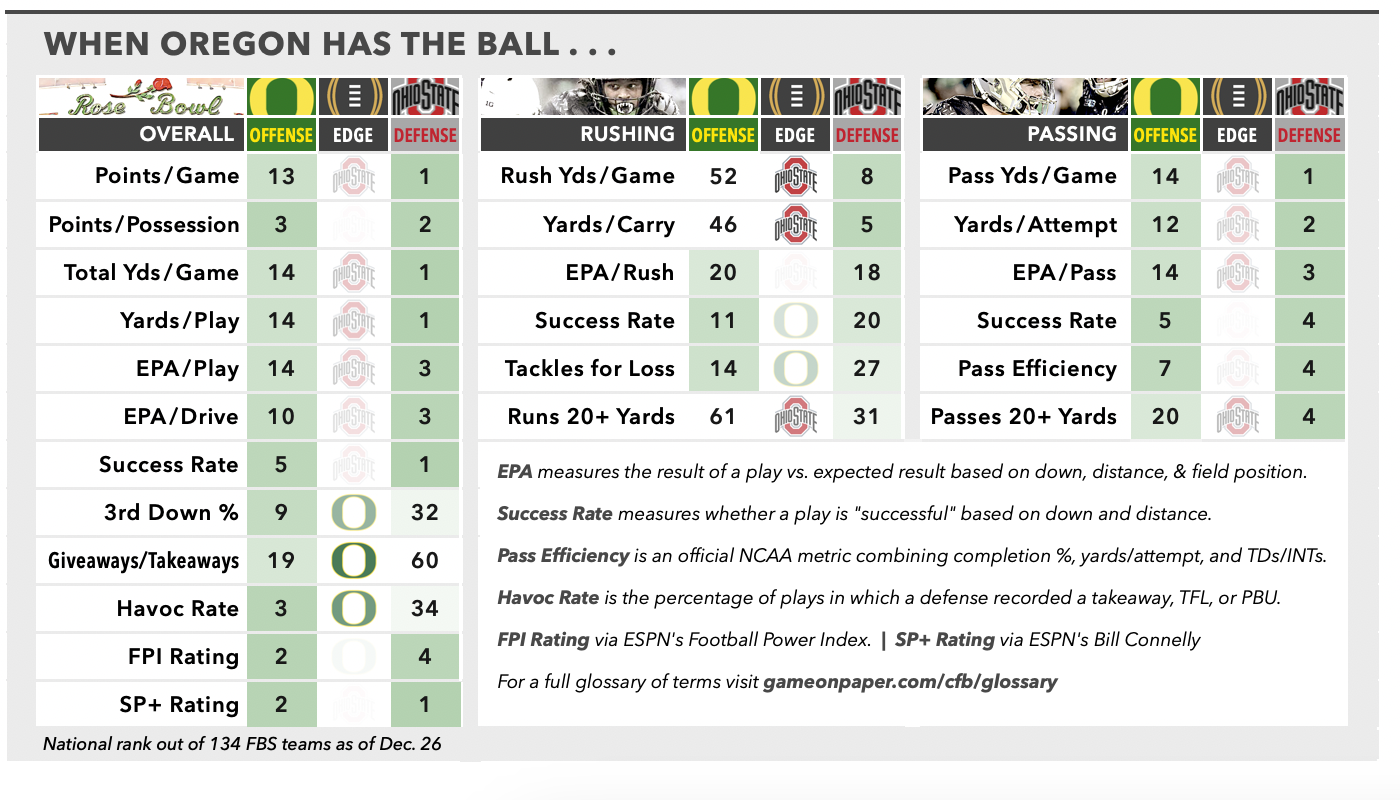
About Round 1 …: The first meeting on Oct. 12 was won on the prolific arm of Oregon QB Dillon Gabriel, who played the game of his life opposite one of the stingiest defenses in America. To call his performance an “outlier” doesn’t do it justice. No other opposing quarterback has even come close to Gabriel’s output against OSU, including the headliners: For some context, he dropped more yards on the Buckeyes than the other 3 Playoff quarterbacks they’ve faced — Penn State’s Drew Allar, Indiana’s Kurtis Rourke, and Tennessee’s Nico Iamaleava — combined, on half as many attempts. (Gabriel finished with 341 yards on 10.0 ypa; Allar, Rourke and Iamaleava put up 322 on 4.6 ypa.) On downfield shots alone, Gabriel was 4-for-4 on attempts of 20+ air yards, including a touchdown and 4 completions that gained at least 32 yards; in its other 12 games, Ohio State has allowed a grand total of 2 TD passes with a long gain of 31 yards.
Two big plays in particular stand out from that game, both coming at the expense of veteran OSU cornerback Denzel Burke. Broadly speaking, Burke is about as bankable as they come at this level, a future pro with 48 career starts. Against Oregon, he was torched, giving up 7 catches on 7 targets for 162 yards on the worst night of his campus career. Two receivers, Evan Stewart and Tez Johnson, beat him for big gains on double moves, covering 69 yards and 48 yards, respectively, the latter going for the only downfield touchdown the Buckeyes have given up all year.
By definition, of course, an outlier is an event that’s unlikely to happen twice. Not that the Ducks don’t have the juice: Oregon’s offense is better known for dinking and dunking than stretching the field — like Bo Nix before him, Gabriel ranked near the bottom of the FBS in average depth of target, at 6.9 yards per attempt — but between Stewart, Johnson, and Alabama transfer Traeshon Holden, there is certainly no shortage of deep speed when they need it.
Gabriel leads the nation in downfield completion percentage, per PFF, connecting on 55.8% of his attempts of 20+ air yards. (His counterpart, Ohio State’s Will Howard, ranks 2nd at 55.3%, for the record.) But catching a pair of corners who have played as much football as Burke and Davison Igbinosun (33 career starts) napping is a tall enough order even when they haven’t spent the last week-and-a-half watching their rare lapses on repeat. Factor in All-Big Ten safeties Caleb Downs and Latham Ransom on the back end, and there’s no reason to expect the pickings to be nearly as easy this time around.
Who gets to the QB? The best predictor of how well any secondary will hold up is how difficult its d-line can make the quarterback’s life before the ball leaves his hands. Gabriel is undersized pocket presence, but slippery; per PFF, his pressure-to-sack ratio (10.5%) was the best in the Big Ten, meaning only roughly 10% of his pressured drop-backs actually resulted in a sack. Officially, Ohio State came up empty in the sack column in Eugene, although its vaunted front seven did let Gabriel know it was there, generating pressure on more than a third of his total drop-backs with multiple knockdowns. (Notably, senior edge JT Tuimoloau turned in one of his better outings as a pass rusher against the Ducks, matching a career high with 7 QB pressures.) When the rush was held at bay, though, Gabriel was lethal, going 17-for-22 for 268 yards and 2 touchdowns from a clean pocket.
This time, the Buckeyes are desperate to turn more of those pressures into sacks and/or takeaways. They’ve had more success in the former column than the latter, generating multiple sacks in 10 of their 11 wins; that trend includes productive games against Penn State (3 sacks on a 42.9% pressure rate), Indiana (5 sacks on 30.4%), and especially Tennessee (4 sacks on 43.2%). The win over the Vols was a triumph for the 4 senior starters on the d-line — Tuimoloau, Jack Sawyer, Tyleik Williams and Ty Hamilton — who punctuated their final home game by collectively hounding Nico Iamaleava into deer-in-the-headlights mode. He failed to complete a single pass on 19 pressured drop-backs, finishing with more scrambles on those reps (8) than actual pass attempts (7).
Gabriel is much too poised to put up an o-fer, but every hand they lay on him is one less opportunity for him to drop a game-changer over the head of a trailing DB.
Jeremiah Smith is special: Does Oregon’s secondary have an answer for Ohio State’s brilliant freshman wideout, Jeremiah Smith? Last time, not really: Smith and his senior running mate, Emeka Egbuka, easily exceeded their combined season averages for targets (23), receptions (19), yards (193) and touchdowns (1 apiece). If there was a silver lining for the Ducks, it was that they largely succeeded in keeping the lid on: Smith, inevitably, made one highlight-reel play, an acrobatic, 38-yard grab in traffic in the third quarter, but otherwise averaged a pedestrian 7.8 yards per catch. Egbuka’s 9.3 ypc also came in below the Mendoza line, and the third wheel of the rotation, Carnell Tate, was a nonfactor.
But that’s all small solace. All 3 look like high draft picks (eventually, in Smith’s case), and if there’s an individual DB out there who might inspire confidence lined up across from Smith, in particular, he’s already playing on Sundays.
Meanwhile, the focus on containing the wideouts in the first meeting gave offensive coordinator Chip Kelly an excuse to dust off a few touches for the bit players. Tight ends Gee Scott Jr. and Will Kacmarek and RB Quinshon Judkins were all on the receiving end of explosive plays in Eugene, averaging 19.3 yards between them on six catches. Don’t let the raw stats fool you: This offense presents defenses with as much to worry about at the skill positions as ever.
Will OSU’s O-line hold up? The wild card, as Ohio State fans must be tired of hearing by now, is a banged-up offensive line whose performance has been scrutinized, litigated, and reassessed on a near-weekly basis since midseason. The Buckeyes lost their best pass blocker, left tackle Josh Simmons, to a season-ending knee injury in the first meeting, and their leader on the interior, center Seth McLaughlin, in mid-November to a torn Achilles. The leftovers are a work in progress. The o-line was the goat (not the good kind) of the loss to Michigan, getting soundly abused by the Wolverines’ NFL-ready d-line for what felt like the umpteenth year in a row. But its next time out, critics still ringing in their ears, the same group redeemed itself against Tennessee, paving the way for a fine night on the ground while holding the Vols without a sack.
The angst in the trenches is well-founded. One thing all 8 of Ohio State’s post-pandemic losses under Ryan Day have in common: They’ve been outrushed in every one of them, often by a mile.
It was a closer call in the regular-season loss at Oregon, which ran for 155 yards to OSU’s 141, but even that number was less a reflection of sustainability than it was of a single 53-yard gain by TreVeyon Henderson propping up an otherwise mediocre stat line.
Frankly, the offense could stand to generate a few more explosives, a category in which it has notably declined the past 2 years. At its best, though, it still relies on controlling the trenches and forcing the defense to make no-win decisions about where to commit bodies and attention. Judkins and Henderson are both as healthy as can be for this time of year, the result of a season-long effort to keep them fresh by splitting the workload of a single feature back between them rather than attempting to feed both. Well, this is the moment you’ve been keeping them fresh for. The last thing the Ducks want is to leave themselves vulnerable on the back end by overcommitting to stop the run. Ohio State should do everything in its power to leave them with no choice.
Bottom line: Four straight losses to Michigan is going to fester locally no matter what. But as far as Ohio State’s national outlook is concerned, the rest of the country seems prepared to write off their ongoing issues with the Wolverines as some kind of weird mental glitch specific to the rivalry, with little bearing on anything that happens next.
The team that waylaid Tennessee in Columbus was obviously not suffering from any crisis of confidence. Among the various analytics, the Buckeyes currently rank No. 1 according to SP+, FEI, SRS and Jeff Sagarin, and No. 2 according to FPI. Rivalry stuff notwithstanding, a lot of people still believe OSU and its $20 million roster is the best team in the country on any given Saturday, and both the stats and the oddsmakers back that up.
In a weird way, the October loss at Oregon kinda does, too — as big-ticket losses go, a 1-point margin, on the road, in a twisty game decided at the gun is about as indecisive as they come.
Home-field advantage might have been the least of the factors that aligned behind the Ducks in that game, which also included a plus-2 turnover margin (resulting in 10 points via short fields) and a fortuitous call or two with the game on the line. How many career nights does Dillon Gabriel have in him? How many obscure rules gambits does Dan Lanning have up his sleeve? If that’s really what it takes to drive a stake into the heart of the Buckeyes’ season, pulling it off a second time might be even more dramatic than the first. – – –
• Ohio State 34 | Oregon 29
• • •
Sugar Bowl: Notre Dame vs. Georgia (-1.5)
Carson Beck ended any lingering suspicion about his status over the weekend, officially declaring for the draft following season-ending elbow surgery. That leaves Georgia’s fate from here on out in the hands of his understudy, Gunner Stockton, a redshirt sophomore whose only meaningful action to date consists of 6 possessions in the second half and overtime of the Dawgs win over Texas in the SEC Championship Game. The good news: 4 of those possessions resulted in points, with Stockton contributing to all 4 with both his arm and his legs. The not-so-good news: The other 2 resulted in a 3-and-out and an interception, respectively, and 8 of Stockton’s 12 completions landed behind the line of scrimmage; altogether, he averaged a meager 4.4 yards per attempt.
Nearly every aspect of his game — especially his ability to push the ball downfield — remains TBD.
Up to now, the list of backup quarterbacks thrown into the breach in the Playoff begins and ends with Ohio State’s Cardale Jones, who memorably went 3-0 as a starter to finish off the Buckeyes’ improbable championship run in 2014. That’s where the similarities between Jones, a towering pocket presence with a huge arm, and Stockton, a middle-of-road Jake Fromm-type, end. But then, if there’s one thing Georgia’s championship blueprint under Kirby Smart has never taken for granted, it’s the luxury of a next-level specimen behind center. And if nothing else, Stockton proved in his emergency turn against Texas that he’s not a deal-breaker. Now it’s up to the rest of the team to deliver on its end of the deal.
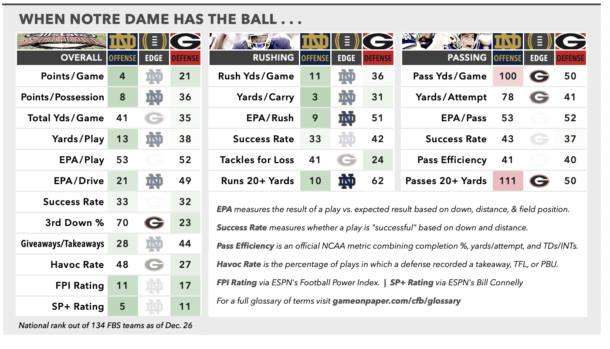
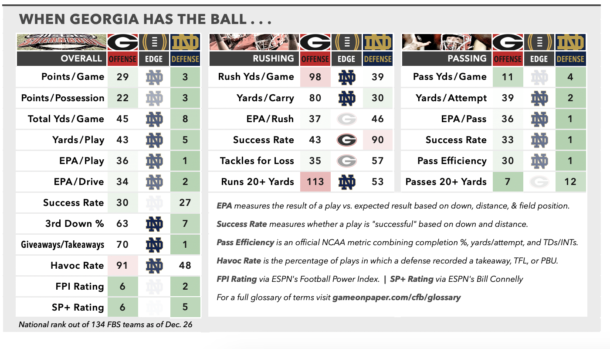
Is there a real Georgia? Thirteen games in, I’m still not sure what to make of this particular edition of Georgia. On one hand, yes, it’s Georgia: 11 wins, SEC champs, loaded roster, business as usual. The Dawgs’ reputation precedes them and their presence on this stage surprises no one. On the other hand … with Beck on the shelf, what is this team reliably good at?
Beck or no Beck, the ’24 Dawgs are an enigma. Their most complete game, the one in which they most resembled the platonic ideal of Kirby Smart football, came way back in the season opener, a 34-3 romp over Clemson. Since then, they’ve flown by the seat of their pants.
At various points the offense and defense have taken turns bailing each out, narrowly surviving slogs, shootouts and multiple overtimes against double-digit underdogs. They had a habit of looking listless for long stretches, including 4 wins in which they trailed or were tied in the 4th quarter. Their average scoring margin vs. FBS opponents (+10.1 ppg) was the narrowest since Smart’s first season as head coach in 2016. They failed to cover the point spread in any of their 7 wins vs. unranked opponents. They staged arguably the comeback of the year in an eventual loss. They followed their worst game, a humbling, 28-10 flop at Ole Miss, with one of their best, a reaffirming, 31-17 win over Tennessee, on consecutive Saturdays. Two weeks after that, they gave up 42 points and 563 yards in an 8-overtime epic against Georgia Tech.
If you could set aside the expectations and the stakes, you might have even thought they were kinda fun, which is about as far from the platonic ideal of Kirby Smart football as it gets.
The upshot of all that is a contender — and Georgia certainly remains a serious contender — with nothing in particular to hang its hat on. Statistically, the Bulldogs don’t stand out in any column on either side of the ball. Man-for-man, the lineup boasts more depth than difference-makers. The only first-team All-SEC pick according to league coaches was an offensive lineman, Tate Ratledge, who missed nearly half the season to injury. The pass rush was capable of taking over games, but only actually did so in the wins over Texas and Tennessee; the wideouts are explosive but struggled with inconsistency and drops; the several aspiring first-rounders on defense remain more potential than production. And now the starting quarterback is on the shelf.
Still, here they are, champions of the most competitive conference in the country and owners of the No. 2 seed. If Beck were still in the fold, it might be tempting to invoke the Kansas City Chiefs, icons of looking sloppy and/or bored right up until the season is on the line. Like KC, Georgia’s track record casts even its jankiest wins in a warmer light reflected off the trophy case.
But I’m sorry, folks, you’re not going to catch me getting grandiose about a brand new quarterback set to make his first career start against a top-10 defense. With Beck’s injury and Stockton’s promotion, it’s time to acknowledge this Georgia team for what it is: A wild card just trying to figure out how to survive one game at a time.
We know who Notre Dame is: Notre Dame had exactly the opposite kind of season: Steady, often dominant, and almost entirely drama-free. Following an early, inexplicable glitch against Northern Illinois, the Fighting Irish blazed through the rest of the schedule like a team on a mission, winning their next 10 games by an average margin of 30.7 points. Half of those wins were decided by at least 5 touchdowns, including start-to-finish beatdowns over Army, Navy and the rotting corpse of Florida State; only 1, a 31-24 decision over Louisville in Week 5, was settled by single digits.
The Irish haven’t trailed after halftime at any point since the final 30 seconds of the loss to NIU in Week 2. Their first-round win over Indiana was significantly more lopsided than the 10-point margin implied, as legions of newly minted Hoosiers skeptics will tell you. Say what you will about their schedule, no one can accuse them of playing with their food.
Of course, there is plenty to say about the schedule. Notre Dame played its way out of the stigma of losing to a MAC school fairly quickly, winning 4 games in the regular season over teams that were ranked at kickoff (Texas A&M, Louisville, Navy and Army) and 2 more against teams that were ranked at some point in the season (FSU and USC, both long since removed from the polls by the time they came up on the schedule in November). Of those teams, though, only Army landed in the CFP committee’s final Top 25, at No. 22, and that was released before the Black Knights’ loss to Navy. Prior to Indiana, the Irish hadn’t faced anyone remotely resembling a Playoff-caliber opponent, and strictly from a raw talent level they arguably still haven’t. For an outfit that has remained in total control of its destiny since September, they’re a wildcard in their own right.
Other key injuries: Carson Beck isn’t the only notable injury casualty. On the other side of the line, Notre Dame will be without its best defensive lineman, 5th-year senior Rylie Mills, who suffered a season-ending knee injury in the win over Indiana. Mills isn’t exactly a household name, but he has been a long-tenured fixture on the Irish front, logging 35 starts over the past 3 years, and broke out this year as the team’s most productive pass rusher despite lining up almost exclusively on the interior. Per PFF, he ranked 6th nationally among interior DL in QB pressures (34) and tied for No. 1 in sacks (7.5), easily outpacing any other Irish defender in both categories. His absence is a big one, literally and figuratively.
There are 2 names to know in the effort to fill the void, one an entrenched vet, the other a burgeoning rookie. The first is Howard Cross III, a 6th-year senior who actually came into the year with more hype than Mills coming off a wildly productive 2023. Cross’ numbers are down in ’24, along with his draft stock — always tenuous to begin with as 6-1, 288-pound defensive tackle. (An ankle injury that sidelined him for most of November didn’t help.) He’s used to being at a dramatic size disadvantage against the likes of Georgia’s massive interior OL; regardless, Notre Dame badly needs him to be his old, disruptive self on the inside. The second is Bryce Young, a true freshman edge rusher who shares a name with the diminutive former Heisman winner and not much else. At 6-7, 258, Young already has an NFL frame and the blue-chip recruiting hype to go with it. In addition to blocking 3 kicks, he came on late as a situational pass rusher, notching 3 QB pressures against USC and an eye-opening sack against Indiana, a welcome development for a unit that hasn’t gotten nearly enough off the edge. Georgia’s tackles are hardly immune to speed; if Young gets an opportunity to pin his ears back, he’s one of a handful of young players in the CFP on breakout watch.
Bottom line: We don’t have to space here to delve too deeply into Notre Dame’s well-documented, decades-long losing streak in “major” bowl games, a run of futility dating back to the 1994 Cotton Bowl under Lou Holtz. Every subsequent ND head coach has contributed to the skid, including Marcus Freeman in his first game in the big chair in the 2022 Fiesta Bowl. Few of those games have even been competitive, including a pair of wipeout CFP losses against Clemson in 2018 and Alabama in 2020. The Irish were huge underdogs in those games, and played like it.
Given how long that’s been the default setting for Notre Dame in big postseason games, it’s worth noting that the Irish are decidedly not huge underdogs in New Orleans: The 1.5-point spread via FanDuel effectively makes this a toss-up. Sure, Beck’s absence is enough to make a serious dent in that number all on its own. But it’s also a reflection of the fact that Freeman’s Irish pass the eye test to an extent that even Notre Dame’s best teams have not in recent memory. They’re sound in the trenches, elite in the secondary, and have run it down the throat of almost every opposing defense they’ve faced, from Texas A&M in the opener to Indiana in the CFP. Dual-threat QB Riley Leonard has proven worth the investment, accounting for multiple touchdowns in every game of ND’s 11-game winning streak.
Meanwhile, the “nobody does that to Georgia” factor is flimsier than it has been in years. Jordan Davis, Jalen Carter, and Nakobe Dean are not walking through that door. But the Fighting Irish, finally, just might.
– – –
• Notre Dame 23 | Georgia 19
• • •
Peach Bowl: Texas (-12.5) vs. Arizona State
Arizona State is 1 of 2 teams in this year’s Playoff field (along with Indiana) whose outhouse-to-penthouse trajectory in the span of a single year defies any previous understanding of the concept of “rebuilding.” The Sun Devils, like the Hoosiers, were afterthoughts in August, infamously picked to finish dead last in the Big 12’s preseason media poll in their first season in the conference.
And, like the Hoosiers, their turnaround is a testament to the power of the portal: Of the 40 players who have logged at least 100 snaps on offense or defense this season, only 2 — 5th-year linebacker Caleb McCullough and reserve OL Emmit Bohle — were on the roster that precocious head coach Kenny Dillingham inherited from the wreckage of the Herm Edwards regime in December 2022. Everyone else who’ll see the field in Atlanta on New Year’s Day is either a transfer or an underclassman in his first or second year on campus, and there are a lot more of the former than the latter.
Unlike Indiana, as far as the national race was concerned, ASU was still an afterthought in November.
The Devils dropped 2 of their first 4 games in Big 12 play to Texas Tech and Cincinnati, and didn’t appear in the AP poll until Nov. 17, when they debuted at No. 21 on the heels of a 24-14 upset at Kansas State. That was the beginning of a late surge that included a wild, 28-23 win over BYU for the conference lead; a 49-7 massacre at rival Arizona; and their best performance of the season, by far, a 45-19 romp over Iowa State in the Big 12 Championship Game. If that was your introduction to Arizona State — and for much of the national audience it apparently was — it might have skewed your perceptions a bit. The 26-point margin against the Cyclones matched the scoring margin in ASU’s first 8 conference games combined.
At any rate, if it was up to them, the Devils would have preferred to be back on the field again a lot sooner than Jan. 1. It’s anyone’s guess how much of that late-season juice survived 3 weeks on the shelf. But you know, sustaining it for the better part of December is a heck of a lot better than trying to figure out how to bottle it over an entire offseason.
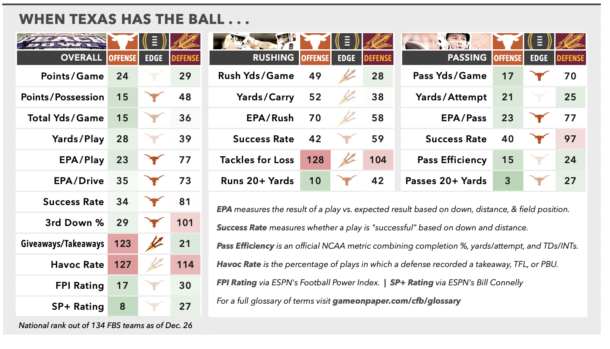
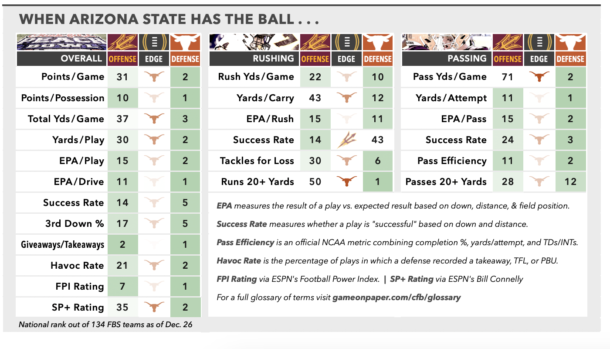
Texas vs. Cam Skattebo: Arizona State RB Cam Skattebo began the season as a Pac-12 After Dark favorite with a funny name, and ended it as a bona fide Heisman candidate. A rugged, thickly-built rumbler who runs much bigger than his listed 215 pounds, Skattebo is the total package of old-school violence and spread-era versatility. He became the first power-conference back since 2015 (Christian McCaffrey) to rack up 1,500 yards rushing and 500 yards receiving in the same season, averaging a workmanlike 25 carries per game. Against Power 5 opponents, specifically, Skattebo led the nation in rushing yards (1,457), total yards (1,925), missed tackles forced (84) and touchdowns (19), personally accounting for more than 40% of ASU’s total offensive output in those games.
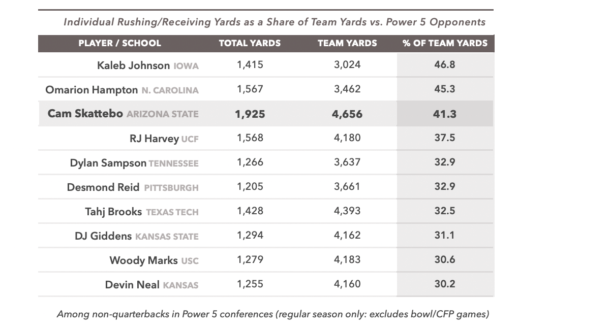
Every opposing defense ASU faced has entered the game fresh off a week of “STOP SKATTEBO” boot camp; none succeeded, or came particularly close. In conference play, he accounted for 100+ scrimmage yards in every game, and for 150+ in all but 2, culminating in a 208-yard, 3-TD performance in the Big 12 title game that made the entire country sit up straight.
Skattebo is inevitable. The question against Texas is who’s going to account for the rest?
The Sun Devils’ leading receiver, Colorado transfer Jordyn Tyson, is one ice for the CFP after suffering a broken collarbone in the regular-season finale against Arizona, taking another 20% of the team’s total offense with him. Against Iowa State, the Devils barely knew Tyson was gone: The junior members of the rotation, Melquan Stovall, Xavier Guillory, and Malik McClain, were all on the receiving end of explosive plays from QB Sam Leavitt, refusing to allow the Cyclones to stack the box against Skattebo. Against Texas, the degree of difficulty jumps dramatically opposite a secondary that ranks at or near the top of the country in pass defense by every measure, and a front seven that’s not far behind.
Hidden key? ASU doesn’t turn it over: Handing the ball to a human tank 25 times per game has other advantages, one of which is ball security. Altogether, Arizona State’s offense has committed just 8 giveaways on the year, tied for for 2nd-fewest nationally, and only 2 over the course of their current winning streak (1 fumble, 1 interception). In the same span, the defense has forced 11 takeaways, good for an FBS-best +9 turnover margin since the start of November.
That number is critical to the Devils’ chances against Texas, which comes in tied for the national lead with 29 takeaways. The Longhorns have forced at least one turnover in every game this season, and multiple turnovers in 11 games, often bailing out their own turnover-prone offense. (Texas is +6 in overall turnover margin despite committing an alarming 23 giveaways.) It’s hard to imagine any path to an upset that doesn’t involve ASU finishing in the black.
Arch Manning! Not so much: For all the idle chatter surrounding Texas’ quarterbacks — whoops, almost forgot to make sure Arch Manning‘s name appears in this thing — Texas’ identity over the second half of the season has been decidedly run-first. Since the start of November, the ‘Horns have piled up 200+ yards rushing in four of the last six games, including high-volume outings against Kentucky (250 yards on 5.3 per carry), Texas A&M (244 yards on 5.0 ypc), and Clemson in the first round of the CFP (309 yards on 6.7 ypc). The headliners of that effort, sophomores Tre Wisner and Jaydon Blue, have come a long way since August, when they were just the next guys up following a season-ending knee injury to projected starter CJ Baxter. After their dual romp against Clemson, Wisner and Blue are going to finish with more combined rushing yards vs. Power 5 opponents than any other backfield duo in the SEC.
But we can’t talk about a team committed to running the dang ball without a nod to the real MVPs, the starting 5 on the offensive line, Kelvin Banks Jr., Hayden Conner, Jake Majors, DJ Campbell and Cameron Wiliams. The core of that group (all but Williams) returned intact from last year’s CFP run, and has remained intact this year across all 14 games to date — with one notable exception: The SEC Championship Game against Georgia, where Banks, the most decorated lineman in the country, was a game-time scratch due to a gimpy ankle. Not coincidentally, that was also the only game since Halloween in which the ground game failed to launch: Excluding sacks, Georgia held the ‘Horns to just 58 yards on 2.6 per carry, recording 9 tackles for loss in the process.
The good news going forward: Banks was back in tow against Clemson and turned in solid PFF grades across the board, notably paving the way on Blue’s game-clinching, 77-yard touchdown run in the 4th quarter. And Majors, who left that game in the first half and didn’t return, is expected to be back in the lineup against Arizona State, extending his streak of consecutive starts at center to 56 games.
The not-so-good news: Cameron Williams, who exited the Clemson just game one play after Majors, is doubtful to play on Wednesday due to a knee injury. The composition of the front may not matter much against ASU, whose front seven is… well, let’s just say, not nearly as imposing as Georgia’s. If injuries linger into the later rounds, though, it’s worth keeping an eye on. Manning and Quinn Ewers drive the headlines, but at this point the o-line is running the show.
Bottom line: As a longstanding passenger on the Skattebo bandwagon, I fully anticipate a viral run or 2 that results in a Texas DB getting posterized in the open field. Otherwise, the tale of the tape solidly favors the Longhorns, who should have no problem moving the ball by ground or air, or blanketing what’s left of Arizona State’s receiving corps following the injury to Tyson. (Tyson has coyly suggested to at least 1 local reporter that he has not been ruled out, but that’s almost certainly gamesmanship or wishful thinking, or both.) ASU quarterback Sam Leavitt, a transfer from Michigan State, is a gamer coming off a fantastic month to bring his team to this point against the odds, but he has not faced a defense from the same zip code as Texas’.
File away the good stuff on his part for future reference; don’t get your hopes up for a 60-minute game.
– – –
• Texas 37 | Arizona State 17